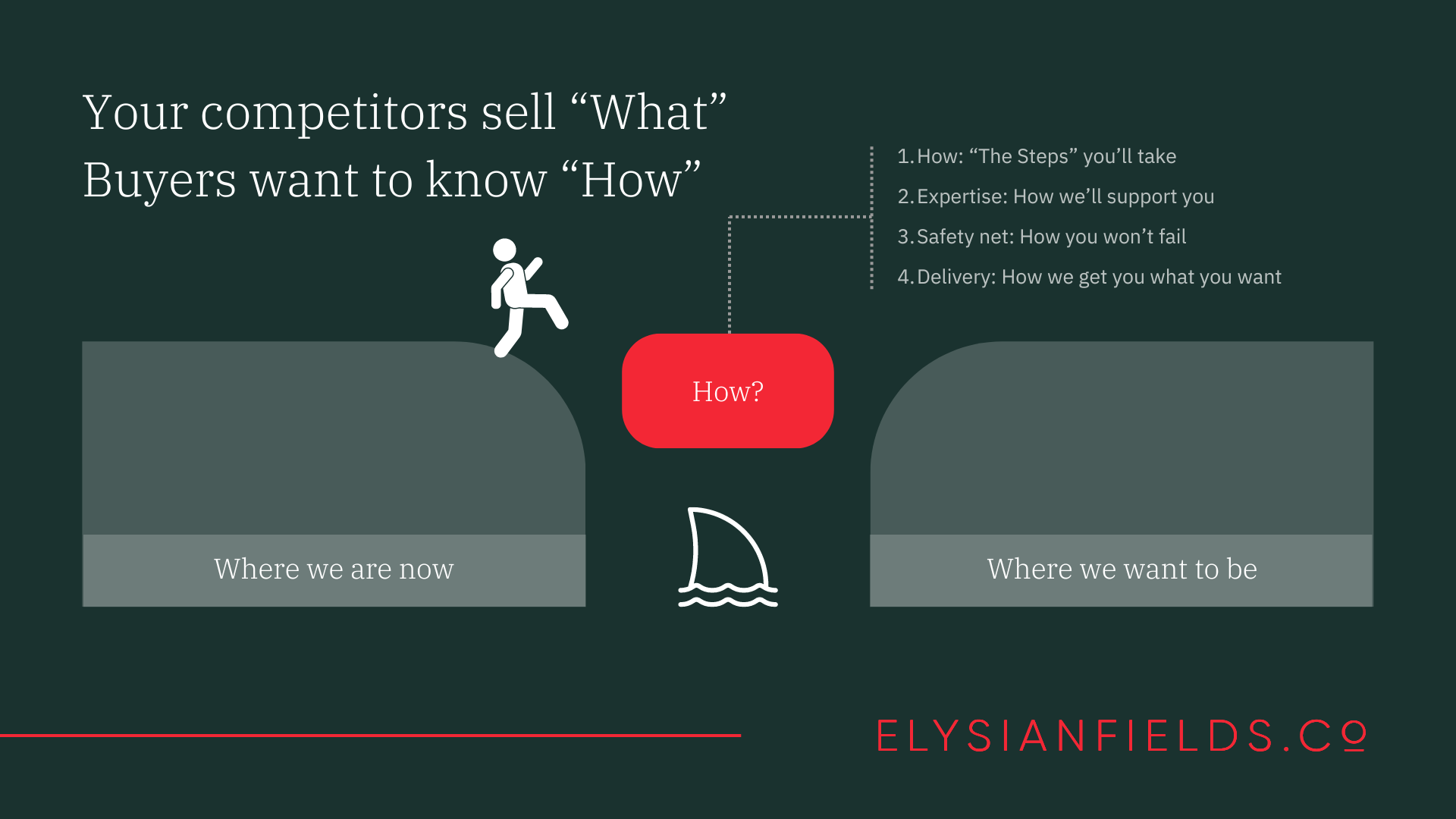In the blogpost ‘How valuable are you?’ I shared the insight that value in the eyes of the buyer often sits in ‘how’ you get them from where they are now to where they want to be, and not in ‘what’ you offer.
In this post I’ll break down the elements you should promote to deliver confidence you can get the buyer where they want to be.
1. How: ‘The steps’ you’ll take your customers through
Who doesn’t like to be expertly led when trying something new? We recommend mapping out the proactive and friendly steps you take to ensure your customer succeeds, and succeeds quickly. Your ‘how’ will be part technology and part consultancy.
Any sufficiently advanced technology requires change on the part of the customer’s organisation. So many products require change management, analytics and workflow optimisation to ensure they can be used properly. Failing to guide the buyer with the hassle they could endure internally can see them churn at the earliest opportunity.
Founders and managers with an engineering mindset tend to hope their product can deliver value to customers with minimal human intervention. Obviously this isn’t the case unless your product is already a commodity offer.
Platforms and other technology innovations can and should offer much value out of the box, but customers churn because they can’t realise the value of products, less that the product itself is inferior to the competition.
The cost of switching, in time, risk and effort, is so large that effort is always made to make the incumbent work. ‘The steps’ will detail how success with the product is guaranteed and ongoing support is a mainstay of the offer.
2. Expertise: How you’ll support them
Your expertise will deliver ‘the steps’. You’ll guide prospects through to success with years of hard acquired insights into how to solve their problem.
Too many companies hide their experts and their insights. This leaves a credibility gap when prospects evaluate a new vendor.
A huge weakness in modern SEO-friendly content is that supposedly helpful articles and playbooks are in fact written by young staff writers for lead generation purposes and would never be used with actual customers.
We often see amazing onboarding content or customer-focused academies created by the engineers and leaders of our client businesses. Yet they are locked up for customers only. While this expert content may or may not be used by the customer, its value would be significant for prospects pouring over websites searching for something, anything, to differentiate a vendor from their competition.
So a quick win for marketing can be to take the expertise reserved for customers and point it at prospects who may, in fact, value it more.
Your expertise is the sum of the insights you can offer. In our due-diligence Credibility Audit product for Investors, we follow a process to evaluate prospective investments. One of the inputs is the vendor’s insights. Expertise comes from deep and validated insights about a problem, honed from years of research. A rogue piece of SEO copy can undermine the perceived expertise of the company entirely. So be careful with the content you share and make sure it’s rich in credibility-boosting insight. Like this nice piece of advice 😉
3. Safety net: How they won’t fail
This one is hard to deliver but oh so worth it.
A money back guarantee may sound like the empty promise of a used-car salesman, but the idea is sound.
Appealing to the buyer’s loss aversion, create a promise that you won’t let the buyer fail. In reality this could mean you work until the promise of the product works (we do that by keeping in touch with clients and tweaking and re-creating strategy based on new insights and test results).
Or it could mean low or free fees until the value of the product is evident. It could even mean reviewing progress in 6 months and delivering ‘free’ consultancy to improve the customer’s results. If it’s seen by the buyer as a commitment to their success then two things happen: first they like you more and think you’re on the same side and second they engage with you regularly, allowing for upsell conversations.
There are surprisingly few examples of safety nets – at least not publicly available ones – because many are retention tactics. This is short sighted. Make them acquisition promises and offer them alongside the steps you take clients on and as a vote of confidence for the expertise you offer.
4. Delivery: How you’ll get them what they want
Do you know what the targets your buyer is trying to hit? Have you spelt out the steps they need to follow to achieve them?
For most organisations focused more on product than service, the answer to both these questions is ‘no’.
As stated, the more advanced your offer the more you need expert customer service. I think there’s a very obvious difference between ‘customer success’ people and expert consultants. The former can deliver ‘the steps’ but the latter will be needed to deliver assurance that they will work for the customer.
The Unfair Advantage Sprint process gathers insights for customer success and product as well as for sales and marketing. These include the Jobs the buyer is trying to get done, the process they follow to achieve their Jobs, the Pains that are stopping them and the Gains they’re seeking (KPIs etc). You’ll also capture the Alternatives and Workarounds deployed by the buyer to get their Jobs done. Armed with this insight you can create a programme (‘the steps’) to ensure they achieve their Gains and remove their Pains. The quality of the delivery you offer defines the ‘How’ you sell, and this is where you value lies.
Every customer is on a maturity journey towards being better at whatever your product or service is helping them with. Maturity journeys provide the diagnostics to understand what the delivery of your value should look like, depending on the maturity level the customer is at. So use these frameworks to help customers get to where they want to be, efficiently and reliably. The initial sale will be easier and churn less likely if you do.
For more insight into how to construct customer success strategies – please watch the webinar on Value Propositions below.
I’d love to know your thoughts!
We work with 2 clients a month – so please get in touch to reserve your place. We’d love to construct something similar to the above with you.

